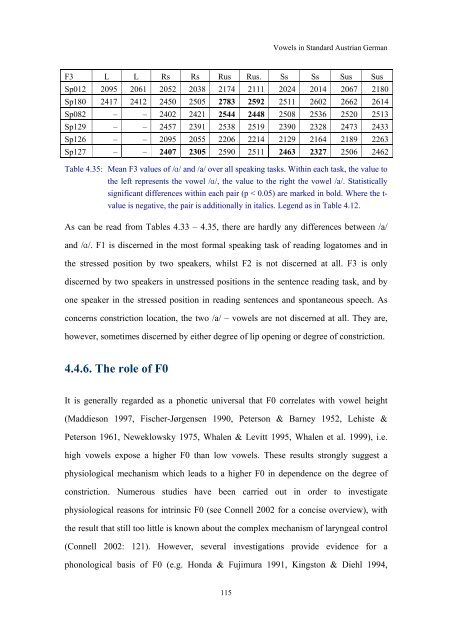VOWELS IN STANDARD AUSTRIAN GERMAN - Acoustics ...
VOWELS IN STANDARD AUSTRIAN GERMAN - Acoustics ...
VOWELS IN STANDARD AUSTRIAN GERMAN - Acoustics ...
You also want an ePaper? Increase the reach of your titles
YUMPU automatically turns print PDFs into web optimized ePapers that Google loves.
115<br />
Vowels in Standard Austrian German<br />
F3 L L Rs Rs Rus Rus. Ss Ss Sus Sus<br />
Sp012 2095 2061 2052 2038 2174 2111 2024 2014 2067 2180<br />
Sp180 2417 2412 2450 2505 2783 2592 2511 2602 2662 2614<br />
Sp082 – – 2402 2421 2544 2448 2508 2536 2520 2513<br />
Sp129 – – 2457 2391 2538 2519 2390 2328 2473 2433<br />
Sp126 – – 2095 2055 2206 2214 2129 2164 2189 2263<br />
Sp127 – – 2407 2305 2590 2511 2463 2327 2506 2462<br />
Table 4.35: Mean F3 values of /A/ and /a/ over all speaking tasks. Within each task, the value to<br />
the left represents the vowel /A/, the value to the right the vowel /a/. Statistically<br />
significant differences within each pair (p < 0.05) are marked in bold. Where the tvalue<br />
is negative, the pair is additionally in italics. Legend as in Table 4.12.<br />
As can be read from Tables 4.33 – 4.35, there are hardly any differences between /a/<br />
and /A/. F1 is discerned in the most formal speaking task of reading logatomes and in<br />
the stressed position by two speakers, whilst F2 is not discerned at all. F3 is only<br />
discerned by two speakers in unstressed positions in the sentence reading task, and by<br />
one speaker in the stressed position in reading sentences and spontaneous speech. As<br />
concerns constriction location, the two /a/ – vowels are not discerned at all. They are,<br />
however, sometimes discerned by either degree of lip opening or degree of constriction.<br />
4.4.6. The role of F0<br />
It is generally regarded as a phonetic universal that F0 correlates with vowel height<br />
(Maddieson 1997, Fischer-Jørgensen 1990, Peterson & Barney 1952, Lehiste &<br />
Peterson 1961, Neweklowsky 1975, Whalen & Levitt 1995, Whalen et al. 1999), i.e.<br />
high vowels expose a higher F0 than low vowels. These results strongly suggest a<br />
physiological mechanism which leads to a higher F0 in dependence on the degree of<br />
constriction. Numerous studies have been carried out in order to investigate<br />
physiological reasons for intrinsic F0 (see Connell 2002 for a concise overview), with<br />
the result that still too little is known about the complex mechanism of laryngeal control<br />
(Connell 2002: 121). However, several investigations provide evidence for a<br />
phonological basis of F0 (e.g. Honda & Fujimura 1991, Kingston & Diehl 1994,












